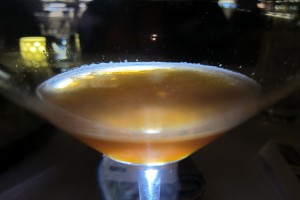You say DAK-ery, I say DYE-kery. However you pronounce it, daiquiri practically screams tropical venues with palmetto fans, thatched rooftops and a sapphire-blue sea. In the past 40 years, this once-unassuming daiquiri somehow morphed into a cliché umbrella drink, served slushy and sweet with chunks of pineapple in a piña colada glass.
It was the date drink of choice at UCLA whenever couples had enough money to go off campus and eat out. Chart House, Gladstone’s, Monty’s Steakhouse, all of them served up a fancy daiquiri with all the trimmings.
Despite its Spring Break affiliations the daiquiri’s origins nod to the working stiff. This simple drink of rum, lime and sugar was first enjoyed by Cuban sailors in the 19th century and introduced to Americans after the Spanish American War in 1898. Limes and rum are the major players in many, many classic cocktails, a partnership of sweet and tart that works very well for quenching thirst (and staving off scurvy).
This drink with the fancy name and paisano roots developed a cult following after Ernest Hemingway reportedly adopted it as his cocktail of choice. According to Jim Meehan in The PDT Cocktail Book, Hemingway was a diabetic and so his mix had maraschino liqueur and grapefruit juice instead of sugar.
Sweet cocktails reached a zenith in the 60s, 70s and 80s and daiquiri recipes changed drastically. Their descendants are the ones you drink in Bermuda, Palm Springs and Vegas. Tasty for sure, but the rum and the lime are completely obscured.
Getting back to basics, we start with the recipe below.
Daiquiri Recipe
2 ounces light (white) rum
1 ounce fresh-squeezed lime juice
.5 ounce simple syrup
Shake with ice and strain into a martini glass or coupe. Garnish with lime wedge
Since the cocktail is so simple, it pays to have the best of ingredients and be somewhat obsessive about proportions. Buy the best rum you can, and note that your local A&P probably isn’t the place to find it. (Read: Set your sights above Bacardi.) Use fresh-squeezed lime juice—it makes a difference. Make your own simple syrup. It’s easy: Just add 1 part water to 1 part sugar in a medium saucepan and bring to a boil. Turn the heat down and simmer for about 3 minutes. Cool and store in tightly sealed container in the refrigerator for up to one month.
Light (also called white or silver) rum is clear and more neutral in flavor than gold, dark or spiced rum. It makes for a very clean, bracing daiquiri. For interesting variations, though, you might try a blend like Banks 5 Island, which is clear but has about 20 different rums in it for more flavor complexity.
In college, rum was like any other spirit—an easy drunk where flavor was not the object. I like to think that times have changed. It’s actually fun to try your spirit straight and identify the various flavors it reveals—the better the spirit, the more nuanced it will be.
In college, rum was like any other spirit—an easy drunk where flavor was not the object. I like to think that times have changed.
Although my recipe calls for the drink straight up you might try drinking a daiquiri frappé—all this means is pouring your blend over cracked or shaved ice. Slushlike without going over to the sloppy side.
For a variation on the daiquiri, it doesn’t hurt to follow in Hemingway’s footsteps with maraschino liqueur. It keeps the fancy taste alive without killing the rum and lime. Add about .25 ounces liqueur to the recipe above. In addition, add a splash (about .25 ounce) grapefruit juice.
Of course, Hemingway always made it a double.

Leave a Reply